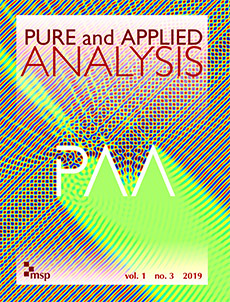Abstract
We consider the minimization of the functional
in the admissible class of functions
Here, is a smooth and bounded domain of and is a given function defining the Navier type boundary condition.
When , the functional can be interpreted as a sum of the linearized Willmore energy of the graph of and the area of on the -plane.
The regularity of a minimizer and that of the free boundary are very complicated problems. The most intriguing part of this is to study the structure of near singular points, where (of course, at the nonsingular free boundary points where , the free boundary is locally smooth).
The scale invariance of the problem suggests that, at the singular points of the free boundary, quadratic growth of is expected. We prove that is quadratically nondegenerate at the singular free boundary points using a refinement of Whitney’s cube decomposition, which applies, if, for instance, the set is a John domain.
The optimal growth is linked with the approximate symmetries of the free boundary. More precisely, if at small scales the free boundary can be approximated by zero level sets of a quadratic degree two homogeneous polynomial, then we say that is rank-2 flat.
Using a dichotomy method for nonlinear free boundary problems, we also show that, at the free boundary points , where , the free boundary is either well approximated by zero sets of quadratic polynomials, i.e., is rank-2 flat, or has quadratic growth.
More can be said if , in which case we obtain a monotonicity formula and show that, at the singular points of the free boundary where the free boundary is not well approximated by level sets of quadratic polynomials, the blow-up of the minimizer is a homogeneous function of degree two.
In particular, if and is a John domain, then we get that the blow-up of the free boundary is a cone; and in the one-phase case, it follows that possesses a tangent line in the measure theoretic sense.
Differently from the classical free boundary problems driven by the Laplacian operator, the one-phase minimizers present structural differences with respect to the minimizers, and one notion is not included into the other. In addition, one-phase minimizers arise from the combination of a volume type free boundary problem and an obstacle type problem, hence their growth condition is influenced in a nonstandard way by these two ingredients.
Citation
Serena Dipierro. Aram Karakhanyan. Enrico Valdinoci. "A free boundary problem driven by the biharmonic operator." Pure Appl. Anal. 2 (4) 875 - 942, 2020. https://doi.org/10.2140/paa.2020.2.875
Information





